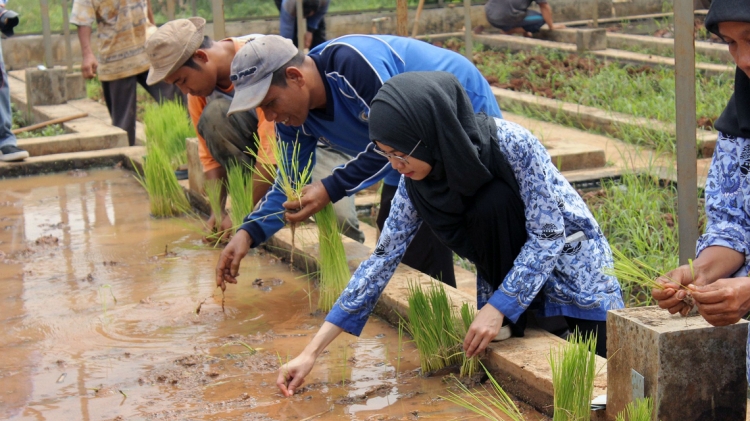Stocky, strong and quick to ripen – that is how Indonesian farmers like their rice, and that is exactly what nuclear science has delivered to them. And higher income, to top it all.
It is the second season that some 200 farmers in this region of East Java have used the variety Inpari Sidenuk (“nuclear dedication” in Indonesian), arming themselves against the effects of climate change while doubling their yields to 9 tons per hectare. Inpari Sidenuk is one of 22 rice varieties developed by scientists at the country’s National Nuclear Energy Agency (BATAN) using irradiation, a process often used to generate new and useful traits in crops (see Breeding new varieties using nuclear techniques).
The IAEA, in cooperation with the Food and Agriculture Organization of the United Nations (FAO) supports researchers in 70 countries, including Indonesia, in the use radiation for agricultural research. The development of new, improved varieties helps increase food supply and therefore food security around the world.
“It is particularly important for us to have varieties that meet the new, more erratic weather conditions brought about by climate change,” said Abdul Rasyid Afandi, a farmer in Mangaran who has planted the new variety on over half of his 2-hectare plot.
Farmers here are able to plant rice three times a year, once in the dry and twice in the rainy season. The length of the seasons has varied more than usual in recent years, resulting in drier overall weather and the spread of new pests and diseases, he explained. As a result, farmers had seen yields with previously used varieties dip below 5 tons per hectare.
The introduction of Inpari Sidenuk has not only led to the recovery of previous yield levels but at 9 tons per hectare has significantly surpassed earlier harvest rates. The variety is much shorter, making it less vulnerable to strong winds, which used to destroy around a tenth of the crop.

The only problem is the lack of seeds available to farmers, said A. Sidik Tanoyo, an Agriculture Ministry extension officer in the district. “It is important that more seeds are produced to increase the area of cultivation, which will contribute to increased productivity and farmers’ incomes,” he said. It is now the task of the country’s agriculture authorities to produce more seeds of the new variety. Such mass production no longer requires irradiation, only the conventional multiplication of seeds.
Seamless cooperation between BATAN and agriculture authorities is crucial in ensuring the distribution of any new variety to farmers, said Ita Dwimahyani, a plant breeder at BATAN’s Centre for Isotope and Radiation Application. Inpari Sidenuk was developed from a local variety in 2007, and released by BATAN in 2011. However, difficulties with distribution have meant that it has taken a few years for it to get to farmers.
“It is difficult for us to pick among the new varieties available and depend on the extension officers for advice,” Afandi said. “We are very enthusiastic about this new variety.” He added that the extra income he hopes to earn in coming years will contribute to the university education of his children and also allow him to save more for his old age.
In the meantime, at BATAN research will continue to develop new varieties in order to keep up with the needs brought about by climate change, Dwimahyani said.
Breeding new varieties using nuclear techniques
Twenty-two rice varieties have been developed by BATAN scientists through a process known as mutation breeding. Applied since the 1930s to accelerate the process of developing and selecting new valuable agronomic traits, mutation breeding uses a plant’s own genetic make-up, mimicking the natural process of spontaneous mutation. The mutation process generates random genetic variations, resulting in plants with new and useful traits.
BATAN scientists use gamma irradiation to induce mutations in seeds and considerably speed up the natural mutation process. After seed irradiation, they test the new mutant plants for various characteristics and select those displaying useful traits for further breeding and subsequent distribution to farmers.
Original source: IAEA
Published on 8 November 2017

